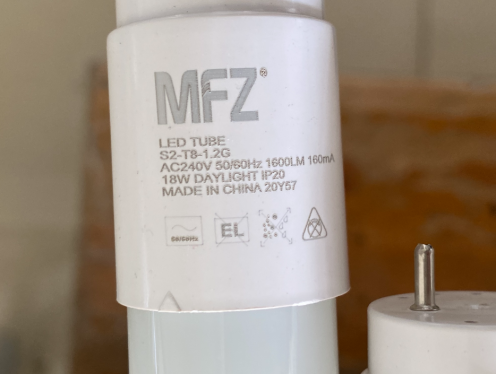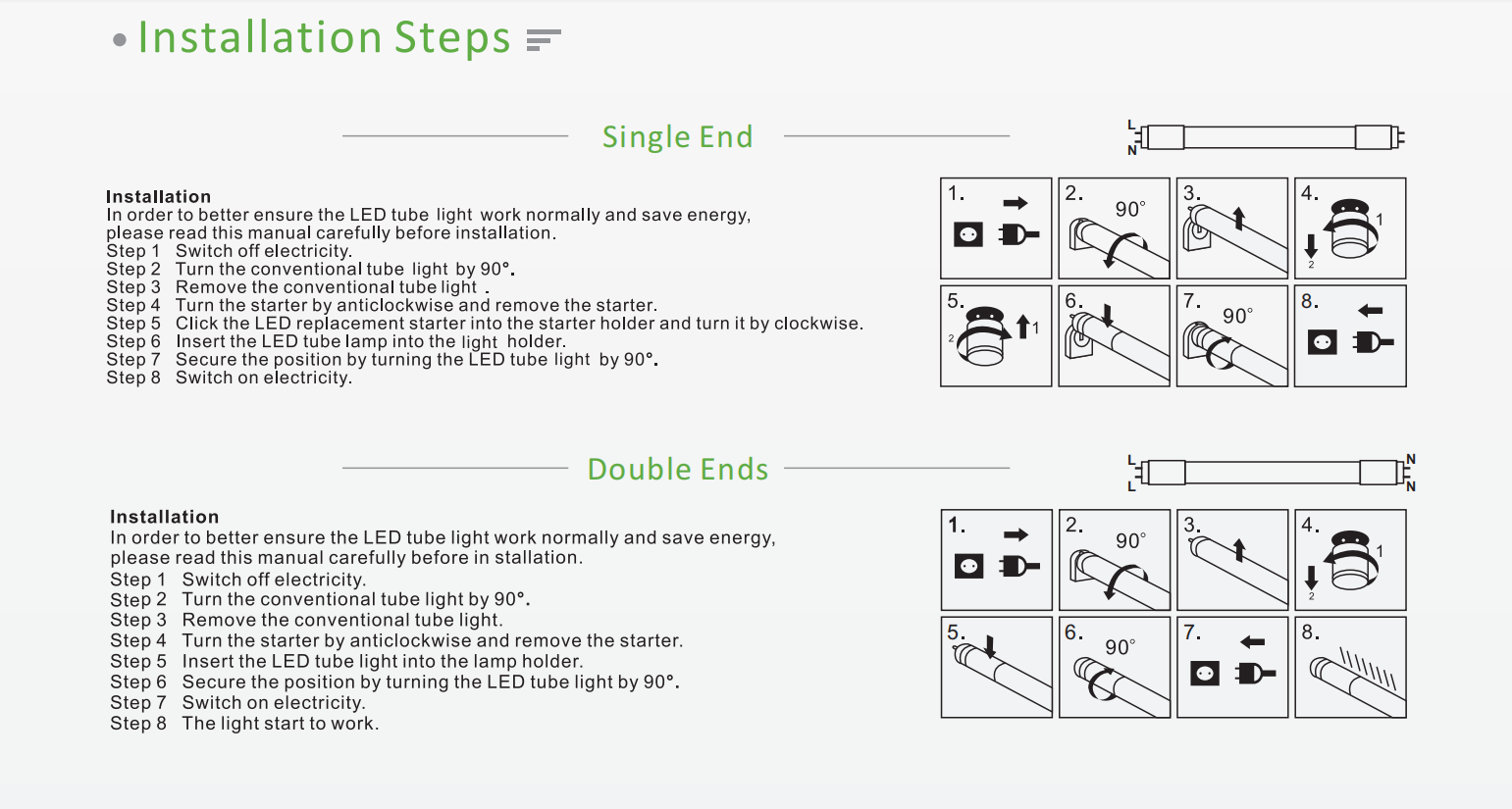In the trend of energy saving and environmental protection, the mercury-free and efficient LED tubes have an advantage over traditional fluorescent tubes. So, how do you choose a cost-effective LED tube? First you need to understand the main categories and wiring methods of LED tubes. Judge the cost effectiveness of conventional LED lamps based on their performance parameters and the certifications required for import and export as well as their appearance and packaging. And finally we will introduce the installation steps of LED tubes. You can choose the most suitable LED lamp for you according to your needs.
Type Introduction
Tube T5 VS T8
First of all, according to the size of the tube, LED tubes are mainly divided into T5 and T8.
T stands for Tube, the number after T indicates the diameter of the tube.
1T = 1/8 inch. 16mm diameter for T5 and 26mm for T8. Generally speaking, the thinner the lamp, the higher the luminous efficiency; T5 tubes are thinner than T8 tubes, which are filled with inert gas atoms with a higher chance of elastic collisions with electrons. The smaller the energy loss, the better the luminous efficiency. The unique nature of the inert gas protects the cathode of the lamp better and further increases the luminous flux output of the lamp, by suitably reducing the lamp filling pressure. As a result, the lamp power is lower, but the total luminous flux is not reduced, thus the luminous efficiency of the lamp is improved, which means that T5 is brighter and more energy efficient than T8.
The T8 tube, on the other hand, is easier to integrate into the built-in power supply.T5 tubes are too small in diameter, so it is difficult to drive the power supply directly into the traditional tube, and the power supply can only be built in through integration or by means of an external power supply. This makes the T8 far superior to the T5, both in terms of replacement demand and the complexity of lamp replacement.
In general, the colour rendering performance of T5 is good, with high efficiency. T5 tube is more comfortable for home restaurants and other places; T8 tube is brighter, with low light decay and long life, more for large squares and other more open places.
Single Ended Wiring VS Double Ended Wiring
Depending on the wiring method, LED tubes are divided into single-ended and double-ended wiring. Double-ended wiring is currently very popular in the market, but its safety is not as good as single-ended wiring. When installing LED tubes, care must be taken that the power supply has been cut off. Otherwise, in the case of double-ended wiring, one end is already in contact with the current and there is voltage inside the lamp, which could result in a risk of electric shock if you accidentally touch the other end during installation.
The International Electrotechnical Commission (IEC) published a safety standard for replacement double-ended LED lamps (LED tubes) in 2014, which regulates the safety of the pins of LED tubes. In terms of contact current, the IEC 62776:2014 standard "Double-ended LED lamps for replacement fluorescent lamps - Safety requirements" states that a test voltage of 500V (50Hz or 60Hz) (rms) is applied and the contact current should be no greater than 0.7mA (peak) when measured.
What you need to know about the parameters and certification of LED lamps
Input voltage, power, PF value
Selecting the right supply voltage, tube power and PF value
(1) The input voltage of the tube directly determines whether your tube can be used locally. Tube supply voltage contains full voltage, and AC power 100-265V can be used. There is also a single voltage, that is, low-voltage 110V or high-voltage 220V. Using other voltage may damage the lighting LED tubes.
(2) The rating of the power directly affects the daily household or industrial electricity consumption.
(3) PF value (i.e. power factor). Under the same power, the higher the PF value, the lower the current consumption. PF value should not be less than 0.5. PF value between 0.95-0.98 shows the lamp performance is better.
Optical parameters such as luminous flux, luminous efficacy and luminous angle
When choosing a tube, it is best to choose a tube with a high luminous flux and luminous efficiency.
The higher the luminous flux, the brighter the lamp will be.
The greater the luminous efficacy, the less power the lamp consumes and the brighter it is. The luminous angle is generally sufficient for your normal lighting.
Isolation of the tube driver
Whether the tube driver is isolated or not has a direct impact on the safety of use and also on the cost. Isolated power supplies are safer and more costly.
Whether the tube is certified, e.g. CB, CE, ERP energy efficiency certification
The more tests a tube has passed, the better its quality is guaranteed. The more certifications the tube has passed, the more energy efficient, green and safe it is to use.
All of the above parameters and certifications are what you need to know when you are purchasing LED tubes.
*We will introduce for you in detail in another article about specific parameters related to tubes:
Five Features of LED lighting that You Can Describe on The Website
*In a separate article we will give you more details on the certification required for the export of luminaires to Saudi Arabia:
What Certificates Are Needed To Import LED Products To The Saudi Market
How to simply judge the quality of LED tubes
1. Look at the appearance of the LED tube
(1) First of all, the appearance should not have cracks and defects, and the various interface parts need to be secure.

(2)Parameters such as the rated voltage range, rated power and rated frequency need to be clearly marked on the LED tube. Tubes with clear print and standardised content are more reliable.

2. Packaging
Look at the packaging of the lamp to see if it is solid and thick enough to protect the tube from damage during transport. Especially when purchasing glass tubes, extra attention needs to be paid to the packaging.
3. Working temperature
The temperature of LED tubes should not be too high during normal operation. Excessive temperatures will accelerate light decay and reduce the life of the LED tube. Also, if there is rapid flickering or very harsh fluctuations when lighting the lamp, then the lamp may have quality problems.
Installation steps of LED tubes
Before installing LED tubes, you need to know that LEDs come with a constant current source and do not require ballasts or glow starters. Generally, for T8 lamps and above, the constant current source can be installed inside the lamp because the lamp space is large enough. Therefore, during installation, the ballast and glow starter can be removed from the original bracket and the lamp can be installed directly.
As the T5 and T4 LED tubes are very small, they cannot fit the constant current source, so the constant current source can only be installed in the bracket, so, generally, the manufacturer will configure the bracket when producing the T4/T5, and the bracket will be equipped with the constant current source. And, the lamp is installed with directional. If the direction is opposite, the lamp does not light up.
The specific steps are as follows.
1 Cut off the power supply - this is a very important point
2 Remove the old fluorescent lamp and the glow starter. Because the LED comes with a constant current source, it does not need a glow starter.
3 Install the LED lamp (note the installation direction: positive and negative poles)

Believe that through the above introduction, you must have a general direction on how to purchase cost-effective LED lamps. If you need to know more about LED lamps and lanterns, welcome to consult us, or visit our website: www.hbsocket.com